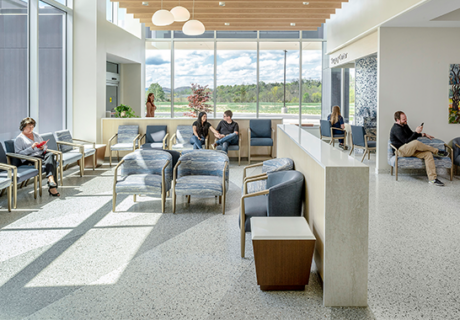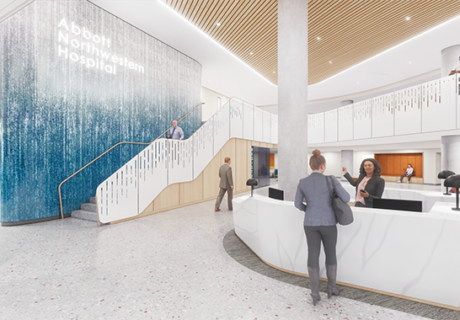Raising The Bar On MOB Design
Lancaster, Calif., is located in the windy, high desert region of Antelope Valley, a fact that made the design and construction of the new Kaiser Permanente Antelope Valley Medical Offices a challenging undertaking—especially in light of the balance that had to be struck between the area’s extreme weather conditions and the provider’s goal to ultimately create a LEED Platinum-certified facility that achieves net-zero energy use.
Antelope Valley, located about 70 miles north of Los Angeles, made sense as a location, though, an area where Kaiser Permanente could accommodate its growing number of members in Lancaster and surrounding communities (114,000 members currently are based there). The building is now one of five Kaiser Permanente facilities in the region. As a specialty MOB, many members are generally there on an ongoing basis to receive care and treatment for chronic needs.
“The nearest Kaiser Permanente hospital is one hour away,” says Pat Reyes-Cappelli, architect and director of design for Kaiser Permanente’s Southern California region and the project director for the Antelope Valley building project. The building, she says, “brings specialty care into people’s neighborhoods, (into) a remote location.”
The project not only enabled Kaiser Permanente to consolidate specialty services located in existing, older office buildings in the Lancaster region, but the square footage reflects an almost doubling of specialty space from what had previously been allocated, Reyes-Cappelli says. At 136,580 square feet, the building supports 20 specialties with 94 exam rooms as well as a laboratory, imaging, pharmacy, an infusion center, general surgery, physical therapy, occupational therapy, and other services.
Opened in September 2014, the building—from exterior shell to interiors palette—reflects its surroundings as its systems respond to them.
Desert design
“Antelope Valley gets an average annual rainfall of just over 7 inches and has the highest temperature change from day to night of any other region in the country,” says Stephen Carroll, a principal with the project’s landscape architect, EPTDesign Inc. (Pasadena, Calif.). “And Lancaster is famous for its ripping winds.” Those winds average around 25 mph, with speeds reaching as high as 90 mph.
The wind, in particular, inspired the building shape. “We wanted to leverage the wind instead of trying to fight it,” says Randy Regier, president of Taylor Design (Irvine, Calif.), the architect of record who led the design-assist delivery. An A-shaped (trapezoidal) building was chosen. It contains two wings, north and south, each forming a protective wall along an open interior courtyard. “We determined that that building shape responded better to wind than a rectangular building. We studied at least a half-dozen configurations and arrived at this one based on light and wind studies.”
A 220-foot-wide by 42-foot-high undulating glass portion of the façade was also shaped by the elements, the design solution that allows winds to roll along the building’s side, dispersing and decelerating its forceful impact. “The orientation and shape of the glass curtain wall functions to direct the wind around the building and away from entrances and patio areas, without standing bluntly into the wind,” Regier says.
The shape reduces heat gain, too. “As you tip the glass out, you reduce the impact of the direct sunlight hitting a flat, vertical plane,” he says.
Strong winds can come with benefits, too. Kaiser Permanente purchased a wind turbine generator system to help meet its goal of achieving a net-zero campus for all power-related energy use. “Turbines have an advantage over solar in that they require less water to maintain and are less affected by windblown dust and dirt, which are common occurrences in this desert environment,” Regier says.
The glass curtain wall encloses a two-story atrium while interior clerestory windows harvest daylight from the atrium for exam rooms, nurses’ stations, and offices. Elsewhere, the building is flooded by natural daylight from the inner courtyard. This allows lights to remain off during the daytime, as determined by sensors and monitoring devices, and LEDs are used when light sources are necessary.
“The distance from a window to the opposite window is narrow,” says David Summers, principal with the engineering firm Glumac (Los Angeles). “This building really uses the old-school philosophy of getting people to the natural light.”
Cold nights let the building cool off naturally, too, which means that HVAC units can be turned off. When needed, the units use economizers and proportional values of outside air, solar hot water reheat coils, and evaporative coolers to reduce total conditioning. Additionally, a high thermal insulation value for exterior walls and high-efficiency glass, glazing, and roofing all further enhance thermal performance and reduce heat transfer.
The building uses a reclaimed water system for toilet flushing and irrigation that satisfies 100 percent of that particular demand. Using recycled water for flushing, alone, will realize almost 262,000 gallons of reduced potable water consumption annually, or about 46 percent of all water used inside the building, Regier says.
The team is actively pursuing LEED Platinum designation for new construction, and the goal of net zero is anticipated to be accomplished once the wind turbine is installed and operational.
Campus creation
A 25-foot-tall aluminum butterfly sculpture marks the entry to Kaiser Permanente’s Antelope Valley campus, followed by a first glimpse of the distinctively designed paths and landscaped grounds. “It helps bring life to that community and that area,” says Rashad Morton, senior project manager with McCarthy Building Cos. Inc. (Newport, Calif.), the commercial builder for the project.
In fact, the campus is a key component to the project’s success, with one of the provider’s goals being to serve the community at large, says John Kouletsis, chief architect and vice president of strategy, planning, and design for Kaiser Permanente. The provider’s architecture, particularly of the last 15 years, he adds, emphasizes public connections and promotes healthy lifestyles.
Part of how that emphasis was reflected on this project was through the development of 12 acres of the 44-acre medical campus, which features approximately 1.5 miles of looped trails that meander past or connect to outdoor “rooms” including an amphitheater, play zone, café, and staff conference patio. The design responds to an organizational belief that not all healthcare activities take place inside a building, Reyes-Cappelli says.
EPTDesign filled the grounds with native and adaptive plants—both local and regional—including a meadow of poppies. Offering height and shade are thornless mesquite trees with hanging foliage, palo verde trees with distinctive green bark and yellow flowers, and three large, sculpted berms that deflect wind and direct water to rows of canopy-forming cottonwood trees.
“Our vision was to extend the idea of the therapeutic landscape to encompass not just one small portion of the landscape, but the entire medical campus,” Carroll says. “Therapeutic design isn’t just good for patients; it can provide a healing and restorative environment f
or the entire community.”
As for the building itself, the blue-green glass curtain wall, although a solution to environmental challenges, provides a striking visual effect that also gives a nod to the area’s natural assets. Running along it are two-toned poppy (the state flower) and butterfly appliqués made from a painted, semi-transparent vinyl film. “The beauty of these is they’re large-scale (5 feet to 16 feet tall), but they feel light and airy on the architecture,” says Will Ayers, a principal with Selbert Perkins Design (Los Angeles). The firm, along with Exit (Philadelphia), designed and implemented the public art, sculptures, and large building branding elements; SKA Design (South Pasadena, Calif.) developed and implemented the exterior and interior wayfinding and signage design and plan.
Inside look
From the moment the building is entered, ease of navigation is a focus of the interiors. Occupational and physical therapy, followed by imaging and orthopedics, are the first departments encountered after reaching the reception area, to provide shorter travel distances for user groups with ambulatory constraints, Reyes-Cappelli says.
Seating is available in the first-floor outdoor courtyard for wait times. From there, patients can easily see a large, illuminated LED board that displays identification numbers to indicate when it’s time to come inside for a blood draw or to pick up a prescription in the pharmacy. Cement flooring was selected to create a smooth and uninterrupted plane.
The interior color palette draws from the natural environment with notes of greens, yellows, and oranges. “You get a sense of colors, the atmosphere, and the warm building all wrapped up in that atrium,” Morton says. “It’s got the elements, the patterns, the feel, and look of the whole building.”
The concourse space represents the heart of the building and contains a large interactive touch screen where visitors can access general information about Kaiser Permanente, specific information about services available within the building, and even live performance data about the energy savings produced on-site.
“The concourse is the central circulation area,” Regier says, “with an open staircase to the second level, as well as high-speed elevators to the second and third levels.” Upstairs are distinct waiting areas for each department, intentionally separated by large breaks of floor space. The situating of these waiting areas offers quiet environments and close navigation for members to conveniently and privately move on to the interior exam areas.
Throughout, the space features large windows with mountain views and succulent plantings as well as warm wood tones.
Today and tomorrow
Outpatient facilities, where approximately 80 percent of Kaiser Permanente’s care is delivered, will continue to be an integral part of its membership experience; patients often have their first exposure to the system in the medical office building. But as healthcare adapts to new care models and emerging technologies, buildings will need to adapt, too.
“As the industry continues to change, the design of outpatient facilities, like the one in Antelope Valley, must be adaptable and flexible,” Kouletsis says. “It’s also critical that the technology backbone be robust to support not only the care of today, but new care modalities in the future with little or no remodel cost.”
The new building addresses this expectation for flexibility and versatility in several ways. In the short term, each exam room module can be used by a variety of professionals and specialties without requiring a remodel. Furthermore, private doctors’ offices were designed using the same square footage and infrastructure as exam rooms, thereby allowing these offices to be converted to clinical space in the future, if needed. Or, Regier says, those same rooms could also be converted into network offices for doctors to practice telemedicine. Shell spaces were included, as well, for even longer term growth.
“In the foreseeable future, we will need buildings,” Kouletsis says. “But what happens in those buildings will be different.”
Sharon Schnall is a freelance writer based in Ohio. She can be reached at schnallwriting@yahoo.com.




